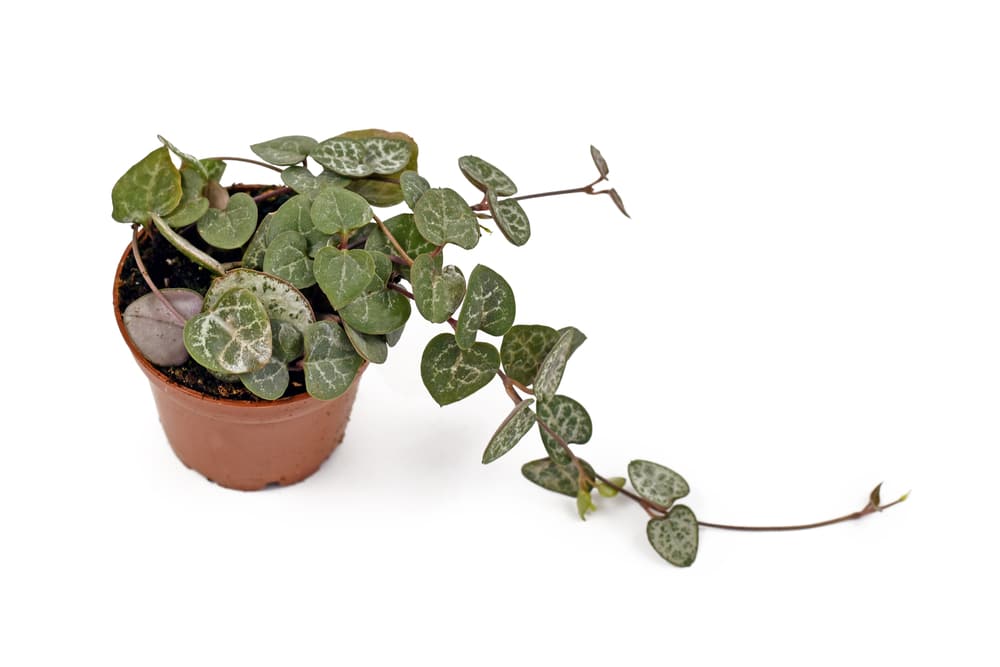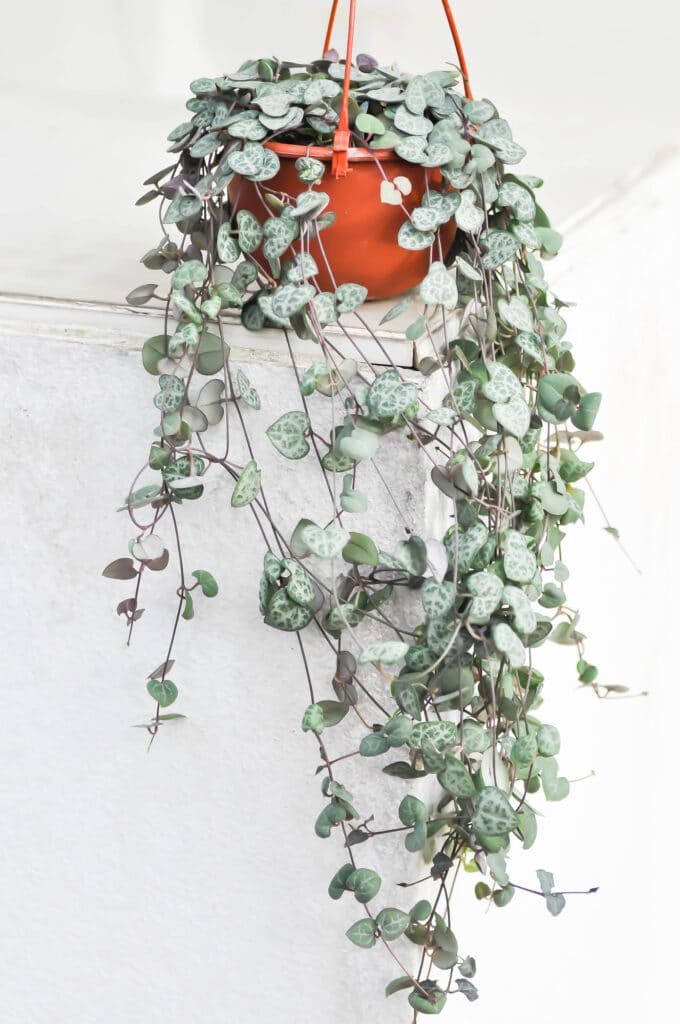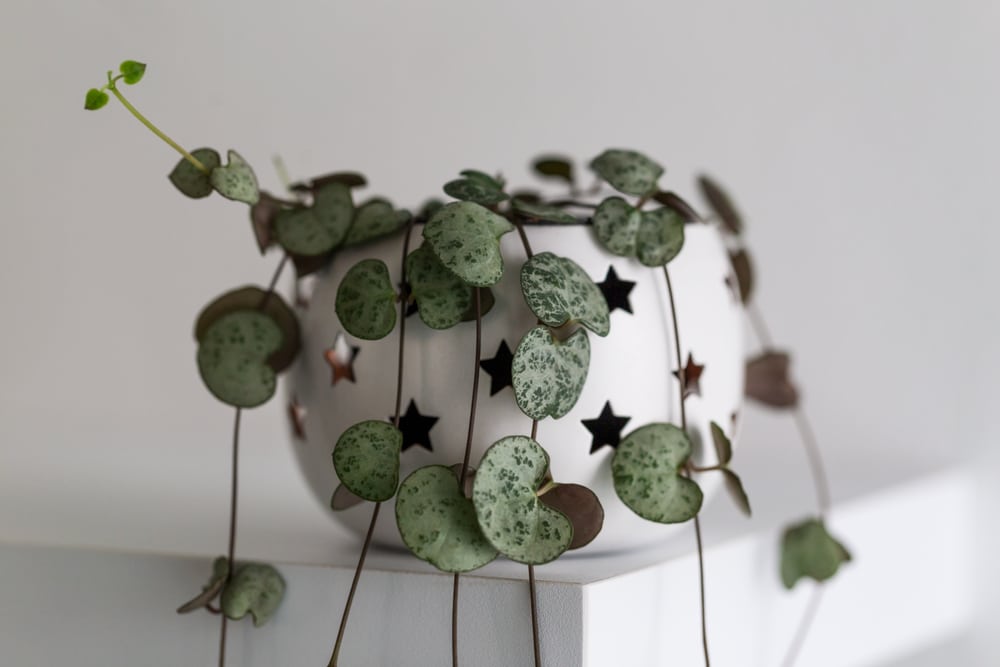A trailing evergreen with enchanting heart-shaped foliage, Ceropegia Woodii has been stealing the hearts of houseplant parents for years. String of Hearts’ delicate, slender growth adds a rich, understated elegance to wherever it calls home. Caring for this houseplant is relatively fuss-free, though it does have rather specific needs like most succulent-type plants.
String of Hearts Origin & History
Native to South Africa, Zimbabwe, and Eswatini, Ceropegia woodii is a tender perennial that grows on rocky outcrops. It is also commonly known as Rosary Vine, Chain of Hearts, Sweetheart Vine, Hearts-on-a-string, and Collar of Hearts.
String of Hearts was first described to science in 1881 when the botanist John Medley Wood saw it growing between stones in South Africa. In 1894, Wood sent a sample to the Royal Botanic Gardens in the UK for preservation. The species name is a tribute to the collector, Woods (woodii), who spent many years collecting native African plants in the late 1800s- early 1900s.
This plant looks like and needs care like a succulent, but it isn’t actually a succulent. String of Hearts is often mislabeled as a succulent because of this commonality, but it is a member of the milkweed family, Asclepiadoideae.

String of Hearts Care Guide
This section covers everything you need to know about String of Hearts care:
Growth Habit
String of Hearts is a trailing vine that can grow up to 12 feet long, though as a houseplant, it likely won’t get longer than 3-4 feet. The growth is wispy, not bushy and full. Some call the growth straggly or scrambling since it is not uniform or thick. Each strand grows out from the center of the plant, and the heart-shaped leaves grow in opposite groupings intermittently along the stem.
The foliage ranges from deep green to pale green, and there are several variegated cultivars. The classic String of Hearts leaves are dark green with silver marbling and markings along the veins. The color underneath the leaves is either green or purple hue. Popular cultivars have cream or pink variegation.
Each leaf remains relatively small, only growing to ½ inch – ¾ inch long and wide. The white veining makes them look larger and more three-dimensional, allowing the String of Hearts to stand out more than its diminutive size.
This plant’s stems are thin, wiry, and reddish-purple. They are quite delicate and don’t like to be handled. String of Hearts stems get tangled easily, like a mess of yarns, and are difficult to separate, but that’s okay. Intertwined stems create a fuller, denser-looking plant.
The String of Hearts is easily trained to grow around a trellis or up a pole or topiary frame. Slender circle or heart-shaped trellises are especially popular and create an attractive display.
Ceropegia woodii tends to get leggy with significant gaps between the leaves, especially if not getting enough light or water. Even with proper care, foliage can be sparse. Pruning and replanting the new vines in the same pot creates fuller vegetation. To encourage even expansion on all sides, rotate the String of Plants pot every month or so.
Lighting
The best light is bright and indirect. Light is necessary to keep the String of Hearts deep green coloring. A sign of insufficient light is faded colors.
Direct sunlight will burn the foliage, so keep this houseplant a little away from the windowsill. This is especially necessary if you have your String of Hearts in a south or west-facing windowsill. Use a sheer curtain or shade to block the sun during the brightest parts of the day. A north or east-facing window is a preferred choice since direct light isn’t as intense.
A String of Hearts with dark purple undersides is getting too much sun and feeling stressed.
Watering
This sweet plant will let you know whether it needs more water or is lacking. Healthy, well-watered leaves are plump and firm. The leaves will turn soft and pliable if the plant isn’t receiving enough water. They will also be thin and may curl up on the edges.
Ceropegia woodii prefers soil on the drier side. The roots are shallow and prone to rotting if the soil remains soggy. Water thoroughly yet not frequently. This houseplant prefers the top 3-4 inches of soil to be dry before watering. Stick your finger in the dirt every time to be sure you are not overwatering.
When you water it, though, add enough for it to flow through the drain holes. Once it has finished absorbing water and all the extra has drained out, empty the saucer underneath to ensure the plant doesn’t sit in water. One of the best ways to water is to put the whole plant in the sink or bathtub and let it drain there.
As an indoor plant, plan on watering String of Hearts every 1.5 – 2 weeks. The exact timing will depend on the conditions in your home and the dehydration of the soil. Your plant will only need watering once every few weeks in winter when the String of Hearts is resting.
Signs of overwatering include yellowing leaves, leaf loss, and mushy foliage. Always check the soil before watering to prevent this from happening – sometimes, that may mean you only need to water once a month. An underwatered String of Hearts looks wilted and deflated. This succulent-like plant stores water in the leaves and soft, shriveled foliage is a sure sign of insufficient water.
If your String of Hearts experiences any watering stress, it will likely take 2-3 more watering cycles for it to recover fully.
Temperature & Humidity
The ideal temperature for String of Hearts is between 65-75F, and it prefers a humidity range of around 50%.
Extreme temperatures hurt String of Hearts growth and health. In the summer, be aware of where the air conditioning is located in relationship to the plant. During the winter, keep Ceropegia woodii away from heat registers or stoves where it might dry out.
Soil
Use succulent or cactus potting soil. Succulent potting soil mix is designed to drain well and not retain water.
Container
The type of pot isn’t as important as that it must have drainage holes.
Fertilizing
Fertilize String of Hearts every month using a general houseplant fertilizer or a succulent fertilizer. Mix the fertilizer at half strength and add it each month during the growing season, from spring through summer. In the winter, do not fertilize.
Pruning
No pruning is necessary except to control the length or remove overly leggy stems. Any pruned clipping can be propagated to create a new plant baby.
Toxicity
String of Hearts is not toxic to people or animals. It is safe to have around pets and small children.
Repotting
The String of Hearts needs repotting every 12-18 months if it’s a smaller plant. Larger plants will need to be repotted every 18-24 months. Choose a pot that is just one size larger if you want the plant to grow bigger. Don’t use a container too much larger as that could lead to overwatering.
To keep your String of Hearts the same size, repot it to the same container. Repotting is necessary even if you aren’t changing containers because the soil mix needs refreshing. Potting soil contains nutrients that are necessary for plant growth; over time, they get depleted.
The best time to repot the String of Hearts is in the spring or summer, when the plant is most robust.

Ceropegia Woodii Propagation
There are two easy ways to propagate a String of Pearls plant. Soil propagation is the easiest, but water propagation is quicker. Plus, it’s easier to see the root development and progress of the cutting when it’s in water.
Water Propagation
- Choose a vine at least 6 inches long and healthy.
- Use a sterilized, sharp pair of scissors to cut off the stem.
- Carefully remove the leaves on the bottom 4 inches. The stems are extremely thin and fragile, so be careful not to tear them.
- Place the bare end of the cutting in a small container of water.
- Put the container in a location with lots of bright, indirect light.
- In a week or so, new roots should appear.
- When the roots are at least an inch long, plant the cutting in soil and water it well.
- Water so the soil is moist for the next several weeks; this will encourage growth.
- After a few weeks, water and maintain the plant as usual.
Soil Propagation
- Follow the instructions for water propagation up to step 3.
- Place the cutting in a small pot filled with moistened succulent potting soil.
- Put the pot in a location with lots of bright, indirect light.
- Water every week so the soil is lightly moist.
- After a month, check that the cutting is rooting properly by very lightly tugging on the stem. A rooted plant will give resistance. To avoid potentially disturbing the String of Hearts baby, hold off on pulling at it as long as possible. If you see new foliage forming, it’s a good bet it’s rooting nicely.
Ceropegia Woodii Pests & Common Issues
Here are common issues and pests to look out for when keeping Ceropegia Woodii:
Root Rot
This is a disease caused by overwatering. It usually means death for a plant. The signs of root rot include yellow or dull leaves and halted growth. Consistently soggy soil prevents the roots from receiving oxygen, and the plant drowns. If you notice these issues, carefully unpot the plant to check the roots. Rotted roots are mushy and black. The plant may be saved if you cut off the black, mushy bits, and there is still enough healthy root left for the plant to survive.
Mealybugs
These tiny pinkish bugs seek out warm, moist environments and love eating plants. They form white cotton masses on the leaves and stems. Mealybugs are problematic because they feed on plants, making them weak and susceptible to secondary infections and infestations. Thankfully, Mealybugs are easily removed with soap and warm water. Or, you can dip a cotton ball in rubbing alcohol and wipe them off. If the infestation is particularly bad, treat the plant with an insecticidal soap.

String of Hearts and Common Questions & FAQs
Here are some common questions about keeping String of Hearts:
Why are my String of Hearts leaves turning yellow?
Yellowing leaves are either caused by overwatering or insufficient light. Review your watering schedule and make sure the plant is receiving enough light.
What causes large gaps between the leaves of String of Hearts?
This is caused when the plant isn’t getting enough light.
Can I grow String of Hearts in a location with low light?
No. String of Hearts needs adequate light every day to thrive. A plant without enough light will fade and then droop sadly.
Will my String of Hearts flower?
Yes, String of Hearts produces small magenta flowers throughout the year, even indoors.
Why doesn’t my String of Hearts foliage have variegation?
Lack of variegation or marbling is a direct result of insufficient light. Move your plant to a location with more light and give it time to bounce back.
Leaf color also changes with the seasons. This is especially noticeable if you have a pink variegated String of Hearts. As the weather cools, the heart leaves turn darker pink. The pink coloring is also affected by lack of light; if the foliage on your pink variegated String of Hearts is pale, move the plant to a brighter location.
Why is the foliage on my String of Hearts curling?
New leaf growth is usually slightly curled because it is thin. As they mature, the leaves plump and straighten. This is entirely natural.
Matured leaves that curl do so because they aren’t receiving enough light. This is easily alleviated by moving the String of Hearts somewhere where it will get more light. It may take a little while to recover, but it will.
Being a houseplant parent to the String of Hearts is a delight. The unpretentious growth, sweetly shaped leaves, and wispy appearance are quite unlike any other plant. Whether you train it to climb up a pole, let it cascade over a hanging basket, or teach it to grow around a circle trellis, String of Hearts is simply enchanting.

